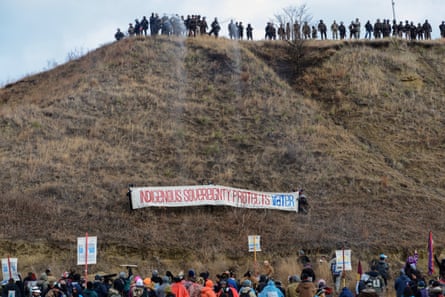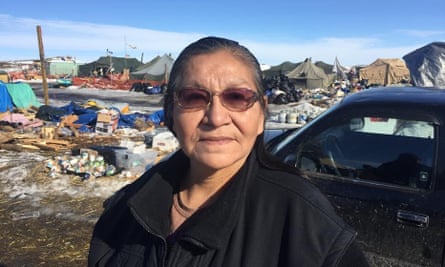A federal judge has rejected a request from indigenous tribes to block drilling of the Dakota Access pipeline, the latest blow to the Standing Rock Sioux after Donald Trump fast-tracked final permits for the last phase of construction.
The Standing Rock and Cheyenne River Sioux tribes challenged the president’s decision last week to speed approvals for the last stretch of the $3.7bn pipeline under the Missouri river in North Dakota. But the US district judge James Boasberg sided with the pipeline corporation at a Washington DC hearing on Monday afternoon and ruled to allow continued construction.
At Standing Rock – where activists known as water protectors have been camping since last spring – indigenous people said the court decision would not discourage them from continuing to fight the project on the ground.
“I don’t think this will stop the movement,” said Paulino Mejia, a 21-year-old who is Ch’orti’ Maya and returned to Standing Rock on Friday. “If anything, it might even make it stronger. I’m going to stay here indefinitely.”
In his first week in office, Trump reversed the Obama administration’s denial of the oil corporation’s key permit, ending a short victory for the tribe and thousands of supporters across the globe who argue that the pipeline could contaminate drinking water and destroy sacred grounds.

The motion from the Cheyenne River tribe, which is part of the Great Sioux Nation, requested a temporary restraining order to halt construction on religious grounds.
The tribe’s lawyers argued that Lake Oahe, where the pipeline drilling is crossing, is made of sacred water that is integral to Cheyenne rituals: “The Lakota people believe that the pipeline correlates with a terrible Black Snake prophesied to come into the Lakota homeland and cause destruction. The Lakota believe that the very existence of the Black Snake under their sacred waters in Lake Oahe will unbalance and desecrate the water.”
Attorneys for the pipeline corporation said in court filings that the company “has the greatest respect for the religious beliefs and traditions of Cheyenne River” but that a restraining order is “not necessary to protect the exercise of those beliefs or preserve those traditions”.
“Cheyenne River is out of time to run this play,” the lawyers added.
Dewey Looking Horse, a 26-year-old Cheyenne River member out at the camps on Monday, said it was upsetting to see the drilling resume last week but that water protectors were committed to staying. “They still want to antagonize Mother Earth.” An oil spill, he added, was inevitable: “It’s going to break sooner or later.”
SJ, a 20-year-old Ojibway activist who has been at Standing Rock since October, said she was not surprised by the ruling. “It’s not like I expected them to be on my side. They never have been on my side.”

“It definitely hurts,” she added, “but we aren’t scared. You can’t bully us off with all your scare tactics.”
The tribe has argued that it is unlawful for Trump’s administration to throw out the lengthy environmental review process that the US army corps of engineers began under Obama, which would have required close scrutiny of potential harms and consideration of alternative routes. Trump has been an investor in the pipeline operator Energy Transfer Partners, and its CEO donated to his presidential campaign.
Since Obama’s announcement in December, the Standing Rock Sioux tribal chairman Dave Archambault II has asked people to go home, saying he feared people could be put in danger by winter storms and flooding, along with ongoing police confrontations.
But indigenous people from across the country have still returned. On Monday, as snow was melting across the camps and turning into mud, activists were continuing to collect supplies and build new wooden structures for long-term camping.
“I think the whole world should be thanking this camp here for showing the world we need to respect Mother Earth,” said Martha Looking Horse, Dewey’s aunt. “Mother Earth is in danger of collapse. These are our treaty lands, and we need to protect clean water.”

In a recent interview, Archambault acknowledged that the tribes face an uphill battle in the US judicial system: “We always knew that the federal court system was against Indian country.
“The whole policy has always been for the federal government to eliminate us. It’s more evident today,” said Archambault, who was supposed to meet last week with Trump officials, but cancelled when he learned that the army corps of engineers had granted the pipeline’s approvals. “What drives the president today? Greed and money.”
Wasté Win Young, a 38-year-old Standing Rock member, said the water protectors would stay strong in the face of continued bad news from the US government.
“No manmade law or court decision or jail can ever hold our spirits and prayers. They can never suppress that,” said Young, who lives nearby in Fort Yates.
“They can’t take nothing away from us,” added her friend Kristen Tuske, a 29-year-old Standing Rock member. “I don’t know what to say. It’s emotional.”
